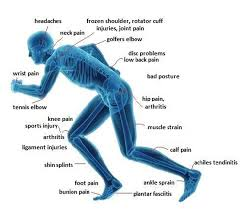
Muscle strains and sprains are common injuries. They happen when muscles or ligaments stretch too far or tear. These injuries can cause pain, swelling, and limited movement. Doctors use specific methods to diagnose and treat them. Understanding the process helps patients recover faster.
What Are Muscle Strains?
A muscle strain occurs when muscle fibers overstretch or tear. This often happens during physical activities like sports or heavy lifting. Sudden movements or poor flexibility increase the risk. Common symptoms include sharp pain, muscle weakness, and bruising.
What Are Sprains?
A sprain involves ligaments, the tissues connecting bones. Ligaments can tear or stretch too far during falls or twists. Ankles, wrists, and knees are prone to sprains. Symptoms include swelling, pain, and difficulty moving the joint.
How Doctors Diagnose Muscle Strains
Doctors start by asking about the injury. They want to know how it happened and the symptoms. A physical exam follows. The doctor checks for swelling, tenderness, and range of motion. They may ask the patient to move the affected area.
Imaging tests are sometimes needed. X-rays rule out fractures. MRI scans show detailed images of soft tissues. Ultrasounds help assess muscle tears. These tests confirm the diagnosis and determine the injury’s severity.
How Doctors Diagnose Sprains
Diagnosing a sprain involves a similar process. The doctor asks about the injury and examines the area. They look for swelling, bruising, and joint instability. Moving the joint helps assess the damage.
Imaging tests are often used. X-rays ensure no bones are broken. MRI scans provide clear images of ligaments. Ultrasounds can show ligament tears. These tests help the doctor plan the right treatment.
Treating Muscle Strains
Treatment depends on the strain’s severity. Mild strains heal with rest and home care. Severe strains may require medical intervention.
Rest
Rest is crucial for healing. Avoid activities that strain the injured muscle. This prevents further damage and allows the muscle to recover.
Ice Therapy
Applying ice reduces swelling and pain. Use an ice pack for 15-20 minutes every hour during the first 48 hours. Wrap the ice pack in a cloth to protect the skin.
Compression
Compression bandages support the injured muscle. They reduce swelling and stabilize the area. Avoid wrapping too tightly to prevent circulation problems.
Elevation
Elevating the injured area reduces swelling. Keep the muscle above heart level when resting. This helps drain excess fluid.
Medications
Over-the-counter pain relievers like ibuprofen ease pain and inflammation. Follow the doctor’s instructions for dosage and duration.
Physical Therapy
Severe strains may need physical therapy. Therapists use exercises to restore strength and flexibility. They also teach techniques to prevent future injuries.
Surgery
Surgery is rare for muscle strains. It is only considered for complete tears or severe injuries. The surgeon repairs the torn muscle fibers.
Treating Sprains
Sprains require similar treatment approaches. The goal is to reduce pain and swelling and promote healing.
Rest
Rest the injured joint to prevent further damage. Avoid putting weight on it. Crutches or braces may be necessary for support.
Ice Therapy
Apply ice packs to the sprained area. This reduces swelling and numbs the pain. Use ice for 15-20 minutes every hour during the first two days.
Compression
Compression bandages stabilize the joint. They limit swelling and provide support. Ensure the bandage is snug but not too tight.
Elevation
Elevate the injured joint above heart level. This helps reduce swelling and improves blood flow.
Medications
Pain relievers like acetaminophen or ibuprofen help manage pain and inflammation. Follow the doctor’s recommendations for safe use.
Physical Therapy
Physical therapy is often needed for sprains. Therapists guide patients through exercises to restore joint function. They also focus on strengthening surrounding muscles.
Surgery
Surgery is uncommon for sprains. It is only considered for severe ligament tears. The surgeon repairs or reconstructs the damaged ligament.
Recovery Time
Recovery varies depending on the injury’s severity. Mild strains and sprains heal in a few weeks. Moderate injuries may take 4-6 weeks. Severe injuries can take several months.
Follow the doctor’s advice for a safe recovery. Avoid rushing back to activities. Returning too soon can worsen the injury.
Preventing Muscle Strains and Sprains
Prevention is better than cure. Simple steps reduce the risk of these injuries.
Warm-Up
Always warm up before physical activities. Stretching prepares muscles and ligaments for movement.
Strengthen Muscles
Strong muscles support joints and reduce injury risk. Include strength training in your fitness routine.
Use Proper Techniques
Learn the correct techniques for sports and exercises. Poor form increases the risk of strains and sprains.
Wear Supportive Footwear
Choose shoes that provide good support. This is especially important for running and sports.
Avoid Overexertion
Listen to your body. Avoid pushing yourself too hard during activities. Take breaks when needed.
When to See a Doctor
Some injuries need medical attention. Seek help if you experience severe pain, inability to move the joint, or numbness. Persistent swelling or bruising also requires a doctor’s evaluation.
Early diagnosis and treatment improve outcomes. Delaying care can lead to complications.
Conclusion
Muscle strains and sprains are painful but treatable. Doctors use physical exams and imaging tests to diagnose these injuries. Treatment includes rest, ice, compression, and elevation. Severe cases may need physical therapy or surgery. Recovery time depends on the injury’s severity. Prevention strategies reduce the risk of future injuries. Seek medical help for severe symptoms. Proper care ensures a full recovery.





Leave a Reply